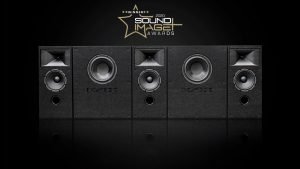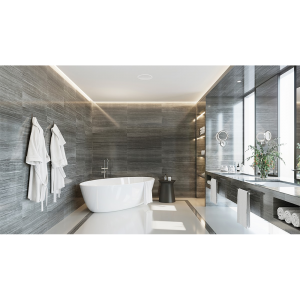Aspect Ratio
Aspect ratio is not hard to understand. Aspect ratio is simply the relation of the width to the height of an image or screen. This is usually expressed as a ratio of W:H where W is width and H is height. The following image shows the three aspect ratios that will be discussed here.
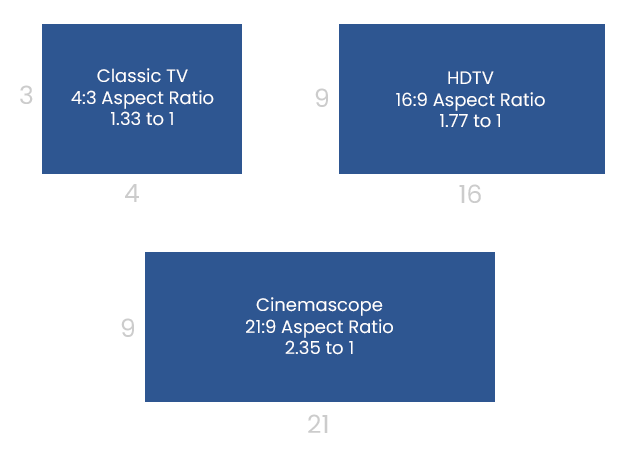
Classic TV or 4:3 Aspect Ratio
The 4:3 aspect ratio dates back to 1917, when the Society of Motion Picture Engineers (SMPTE) adopted it as the standard format for film. With the advent of television in the 1940s and 1950s, the 4:3 aspect ratio was chosen as it closely matched the aspect ratio of 35mm films.
HDTV or 16:9 Aspect Ratio
The 16:9 aspect ratio is the international standard format for High Definition Television or HDTV. It is not hard to understand where the 16:9 aspect ratio came from as 16:9 = 42:32 Most smartphones are 9:16 that become 16:9 when viewed horizontally. 16:9 became the standard for televisions and computer monitors around 2010 and now it is the standard for many platforms, including streaming services like Netflix.
Cinemascope
Cinemascope, the “21:9 aspect ratio” is derived from the anamorphic format that is the cinematography technique of shooting a widescreen picture on standard 35mm film. When projected, images have an approximate 2.35:1 or 2.39:1 aspect ratio. This is usually rounded to 2.4:1. The “21:9 aspect ratio” is actually a 64:27 aspect ratio that can be expressed as 43:33, or approximately 2.37:1, and is near both cinematic movie aspect ratios of 2.35:1 and 2.39:1. A very good technical explanation of the anamorphic format can be found on Wikipedia, see https://en.wikipedia.org/wiki/Anamorphic_format
Cinemascope screens are gaining in
popularity and are seen as the future-proof screen format.
Screens
The choice of screen comes down to the availability of space, seating position and speaker placement. If the loudspeakers are to be placed behind the screen, then an Acoustically Transparent or AT screen will be required and AT screens come in two types, perforated and woven. There is more on AT screen materials later in this article.
If the screen is going to be mainly used for displaying streaming movies and sport then a 16:9 screen will do. If a 16:9 screen is selected then Cinemascope material will be displayed with horizontal bars at the top and bottom of the image as indicated in the picture below.

Bottom: A Cinemascope image on a 16:9 screen
If the screen is going to be used for mostly Cinemascope movies, then the obvious choice is a Cinemascope screen. The trade off will be that a 16:9 image will look like the picture below.

Bottom: A HDTV or 16:9 image on a Cinemascope screen
Acoustically Transparent (AT) Screens
In an ideal world, Acoustically Transparent (AT) screens would not reduce sound quality in any way so that the audience may listen to the audio of the film with the cleanest sound possible. In the real world however, AT screens are not completely acoustically transparent and most manufacturers do not reveal any precise information about sound transmission through their screens. Add to this, there is very little literature available to explain the performance of sound transmission through cinema screens and how measurements were taken to make it possible to explain this phenomenon.
There are various types of cinema screens, e.g. curved, perforated or non-perforated screens, and the sound performance varies in each of them. In cinemas, loudspeakers are located behind the screen so they cannot be seen by the audience. Though these screens are meant to be acoustically transparent, there is always a very small percentage of sound energy which is either absorbed or reflected backwards. Where sound energy is absorbed, the detail will be lost. Backwards reflections are usually lost but these reflections will impact on the sound by causing a small amount of comb filtering as illustrated in the picture below. Comb filtering occurs when a sound adds to itself within a short time interval.

It has been demonstrated that the comb filtering effect reduces as the distance between the loudspeaker and screen increases as shown in the images below. The first image illustrates the comb filtering effect of a perforated screen and the second image is a woven screen.
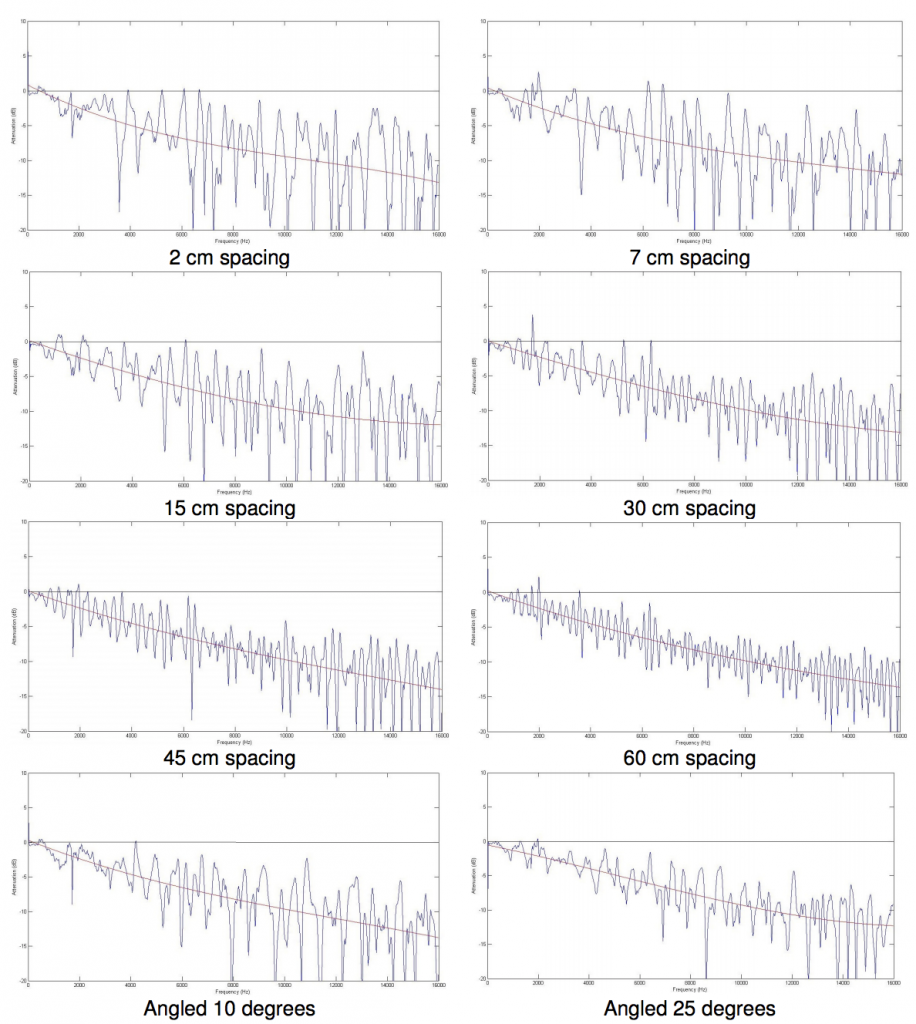
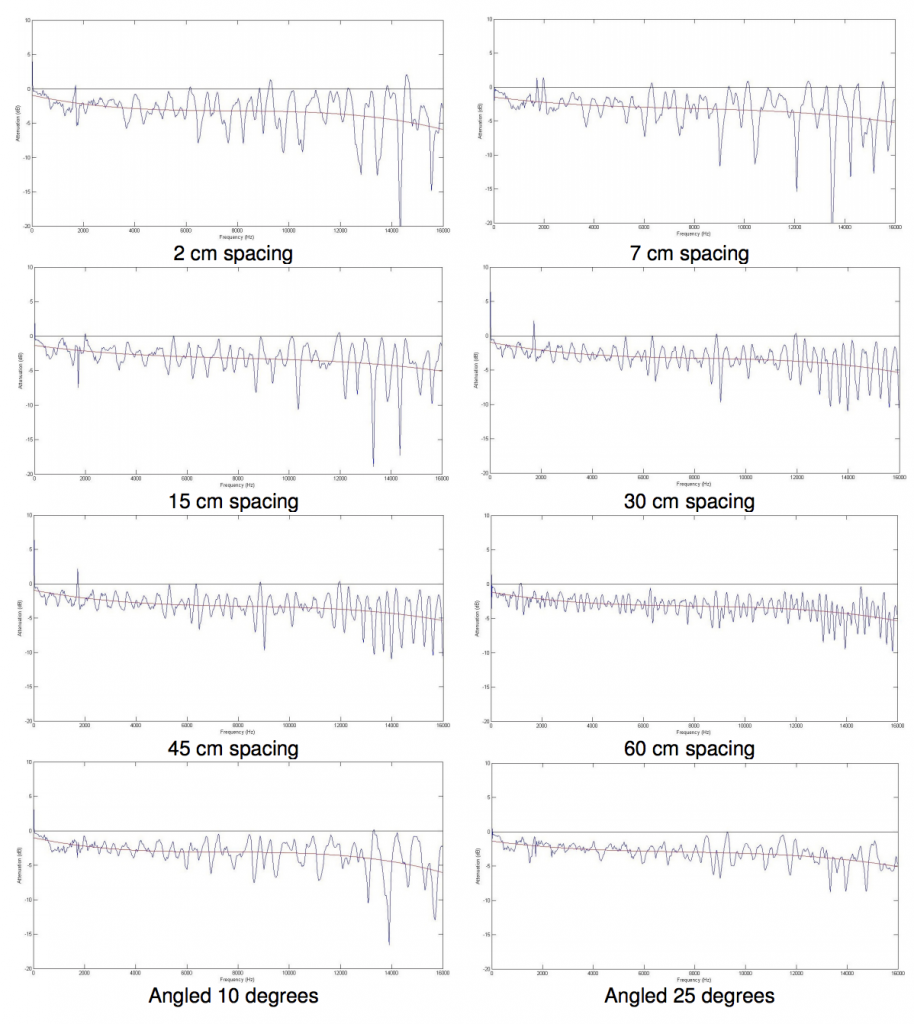
Perforated versus Woven Screens
The images above provide some useful insights into perforated and woven screens. The graphs clearly show the woven screen has less high frequency attenuation and therefore will require less equalisation to produce a high quality sound.
Perforated screens come in standard and mini/micro-perforated varieties, with hole diameters of around 1.2 mm to 0.5 mm respectively. The typical losses through some common, plastic, perforated screens are shown in the image below (MP – miniperforated; SP – standard perforated; MPS – super-mini-perforated).

Woven screens have an irregular surface which tends to scatter the light and this makes the holes in the weave less visible. A side-effect of this is a slightly reduced capacity for the woven screens to reflect the image back to the audience. Modern projectors are high lumen devices so in a home cinema this lower reflectivity may not be a problem as the greater sound transparency of the woven screen is an advantage.
Gain
The brightness of the image reflected back off of the screen’s surface is measured in units of “gain”, or the reflectivity of that surface.
The “gain” number represents a ratio of light that is reflected back from a surface from a light source. This ratio is determined by the light reflecting off of a block of either Barium Sulphate or Magnesium Carbonate, serving as the industry’s standard for a gain of 1.0.
Gain is measured from where the screen appears to be at it’s brightest and this is the very centre of the screen, directly in line with the projector. This is at 0° and known as the “Zero Degree Viewing Angle”. As you move to either side of this position the brightness of the projected image may start to diminish. The point at which the brightness diminishes to 50% brightness from the measurement at the Zero Degree Viewing Angle is known as the “Half Gain Viewing Angle”.
A viewer outside of this viewing angle, also known as viewing cone, will see the image at half the brightness as the audience inside of the cone.
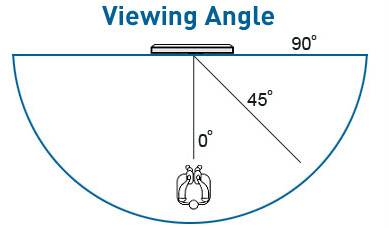
A screen with a gain measurement of greater than 1.0 infers that the image projected back off of the surface is brighter than the image being projected at the surface.
For example; a projector screen with a gain of 1.5 will project back the light 1.5x brighter than the light being projected at the screen. A 1,000 lumen projector aimed at a screen with 1.5 gain will be perceived at 1,500 lumens. The screen achieves this by focusing the light into a more narrow reflective angle, instead of uniformly reflecting the light in all directions. This is why higher gain screens have a smaller viewing angle.
A projector screen with a gain measurement of 0.8 will reflect back at 80% of the original brightness. That same 1,000 lumen projector will be viewed by the audience at only 800 lumens.
Screen Border
The border of the screen should be a dark as possible so that any overscan from the projector is not reflected back to the audience. Generally, the blacker the border, the cleaner the edges of the screen will look to the audience. Some manufacturers use black PVC or a material called flocking, an imitation velvet on the screen border but one of the darkest materials available is Fidelio Velvet
Majestic Cinema Screens
Information about the Majestic Cinema Screens can be found here;




